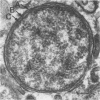Abstract
The tribe Ehrlichieae consists of gram-negative minute cocci that are obligate intracellular parasites classified in the family Rickettsiaceae. Although ehrlichial organisms have been observed in leukocytes for many years, only a few species have been cultured in quantities sufficient for biochemical and molecular analyses. Recents studies on 16S-rRNA sequence analysis and energy metabolism showed that the genus Ehrlichia is closely related to the genus Rickettsia. There is, however, no antigenic cross-reactivity between these genera. Ehrlichial organisms cause a disease called "ehrlichiosis," a noncontagious infectious disease known to be transmitted by a tick in several cases and by a fluke in one case. Ehrlichia spp. infect dogs, ruminants, horses, and humans. Recently, two new ehrlichial diseases, Potomac horse fever and human ehrlichiosis, were discovered in the United States. The etiologic agent of Potomac horse fever, Ehrlichia risticii, is closely related to the known human pathogen Ehrlichia sennetsu. The etiologic agent of human ehrlichiosis is related to Ehrlichia canis, a canine pathogen. In contrast to the genus Rickettsia, members of the tribe Ehrlichieae reside primarily in the cytoplasmic vacuoles of monocytes or granulocytes and cause hematologic abnormalities, lymphadenopathy, and other pathologic changes in the host. However, the actual mechanisms whereby Ehrlichia spp. infect leukocytes, multiply in them, and produce various forms of systemic disease have not been defined. Depending on the ehrlichial species involved, serologic or direct microscopic observation of stained blood smears is currently used to diagnose ehrlichial disease.
Full text
PDF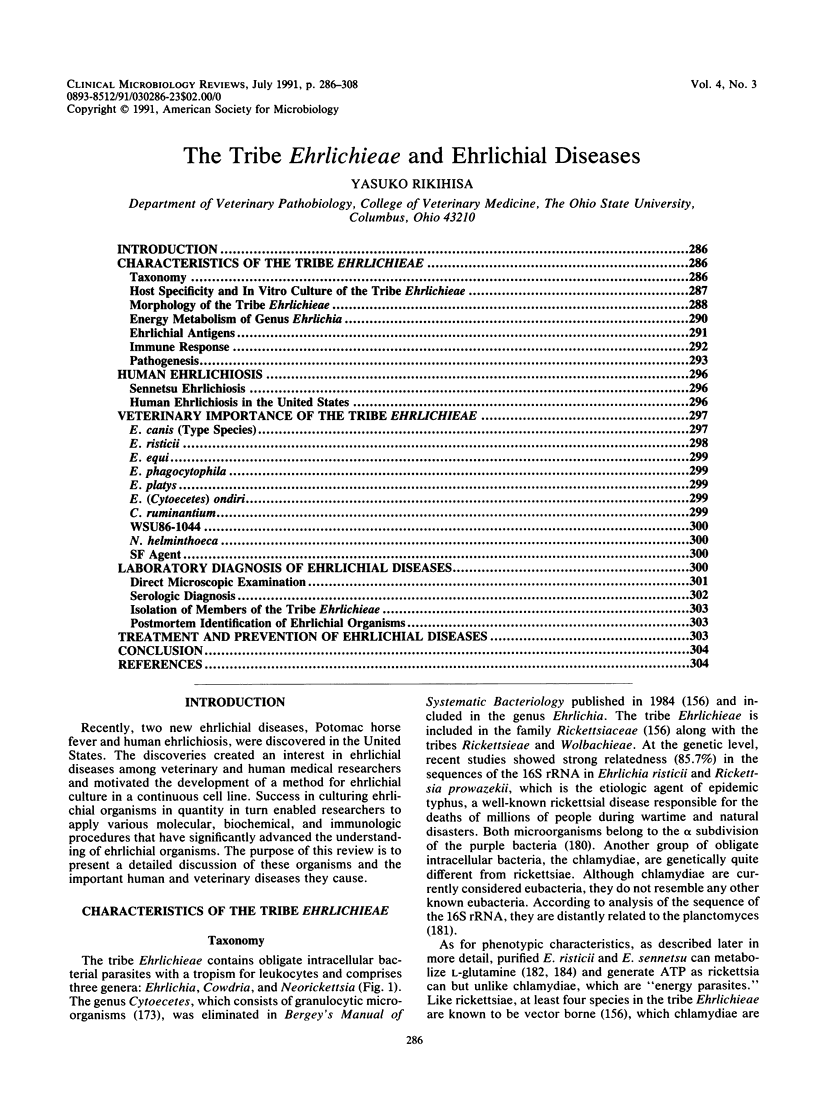
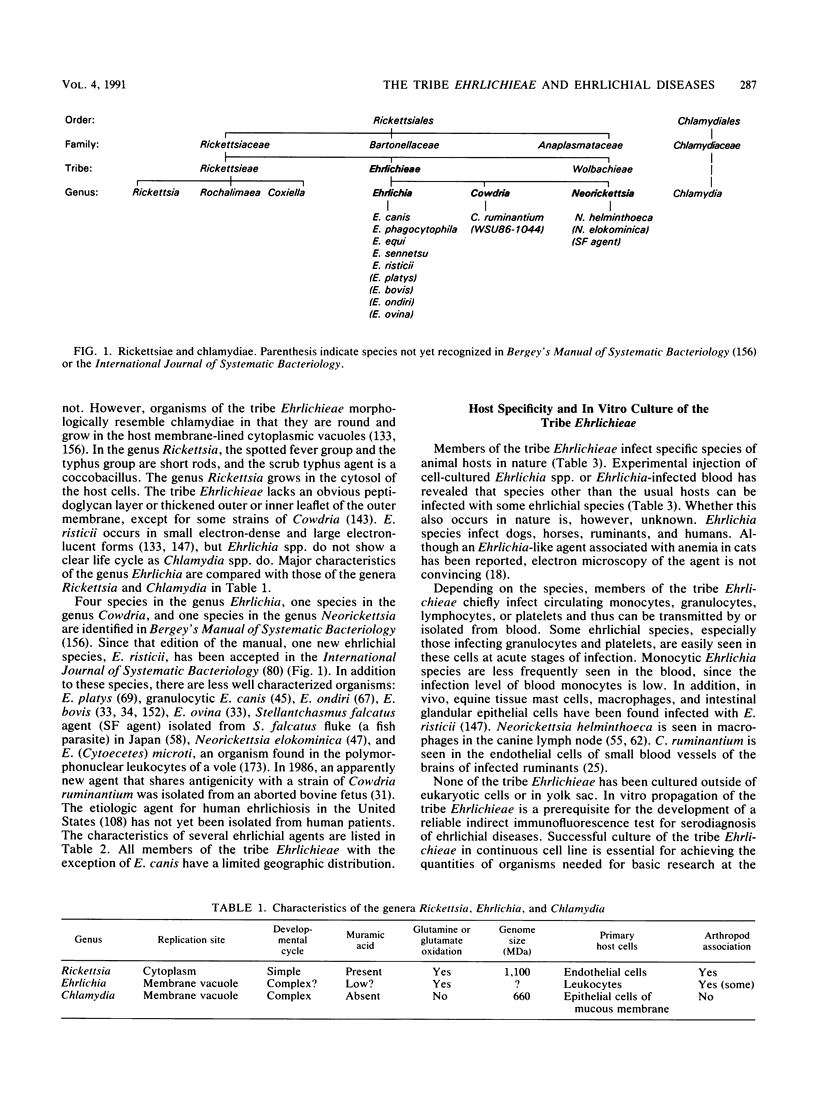
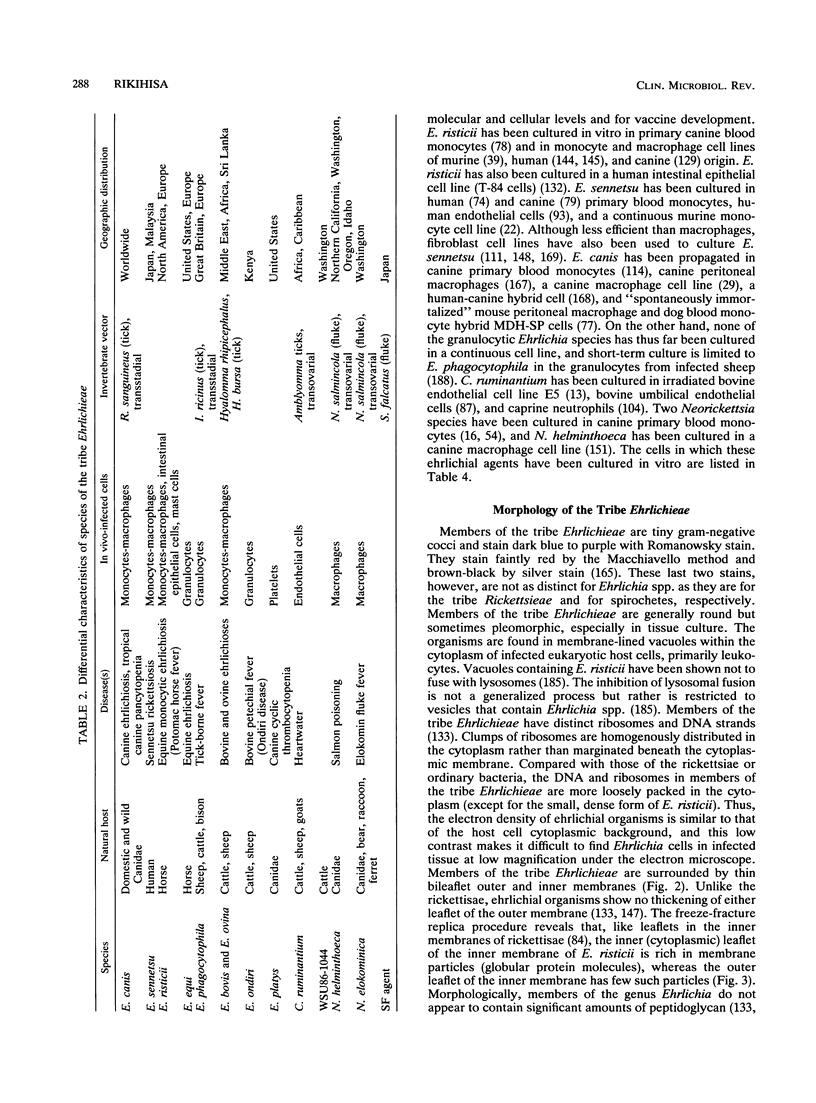
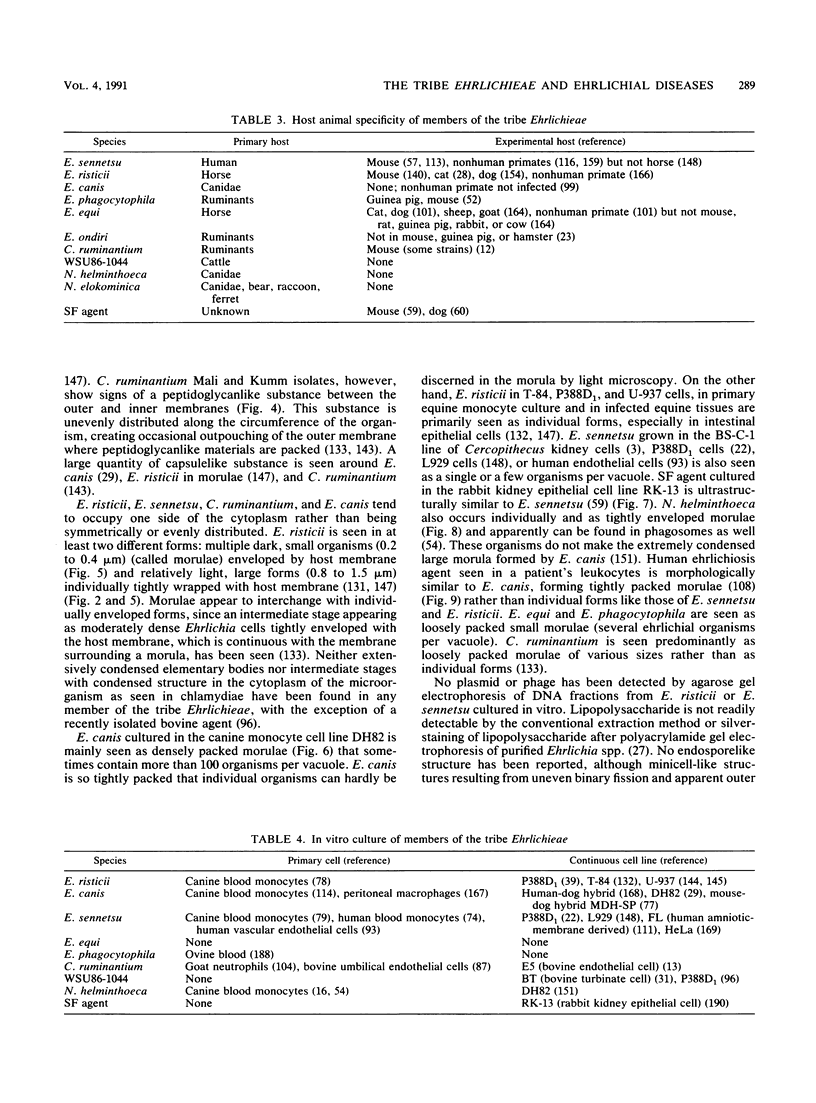
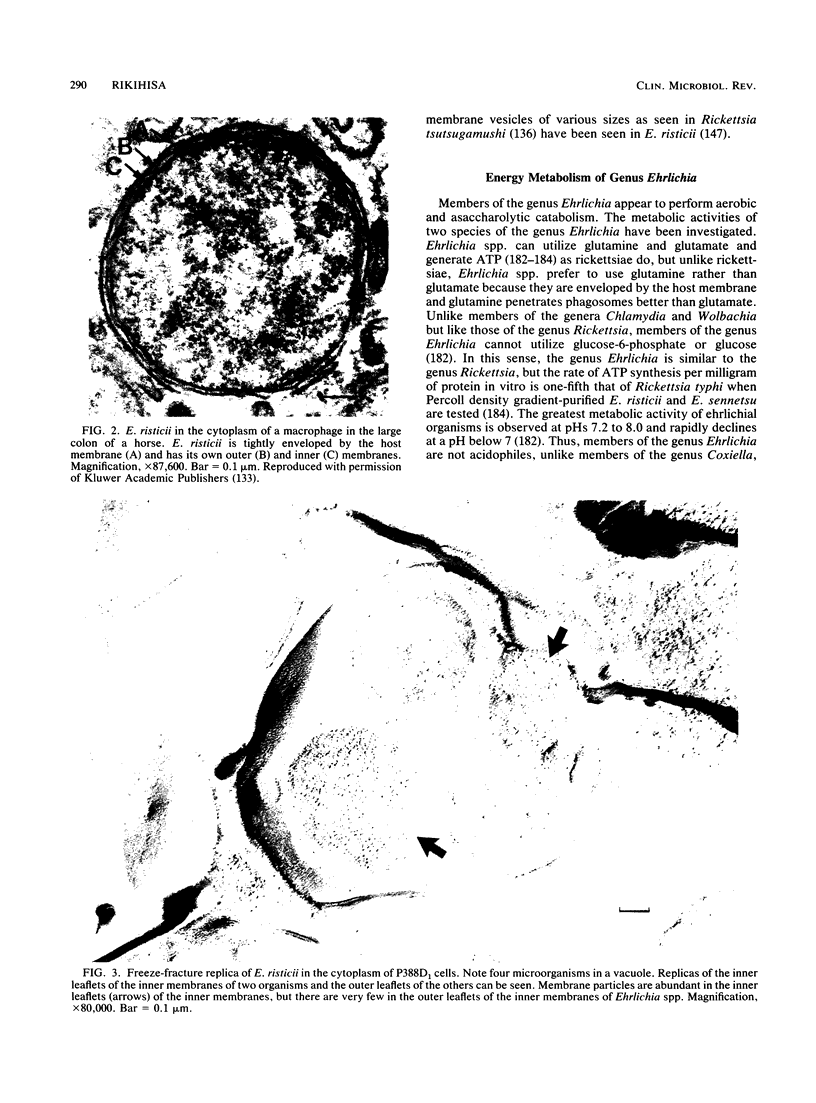
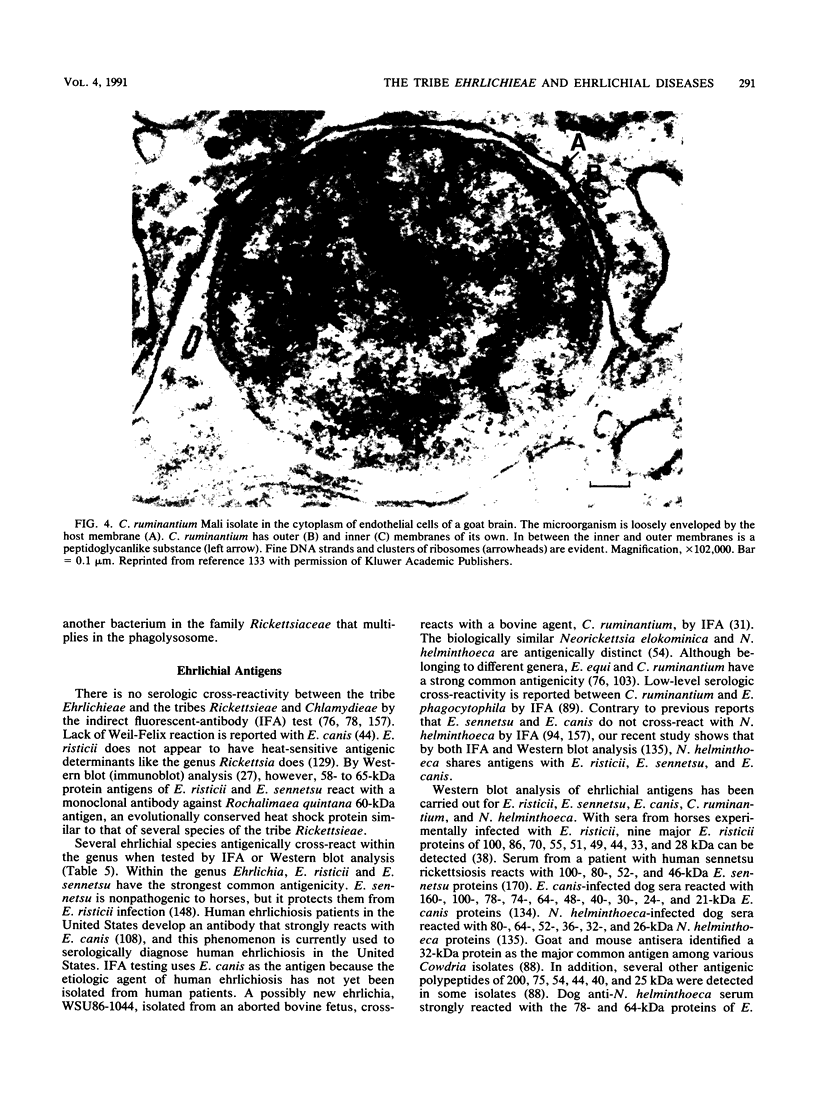
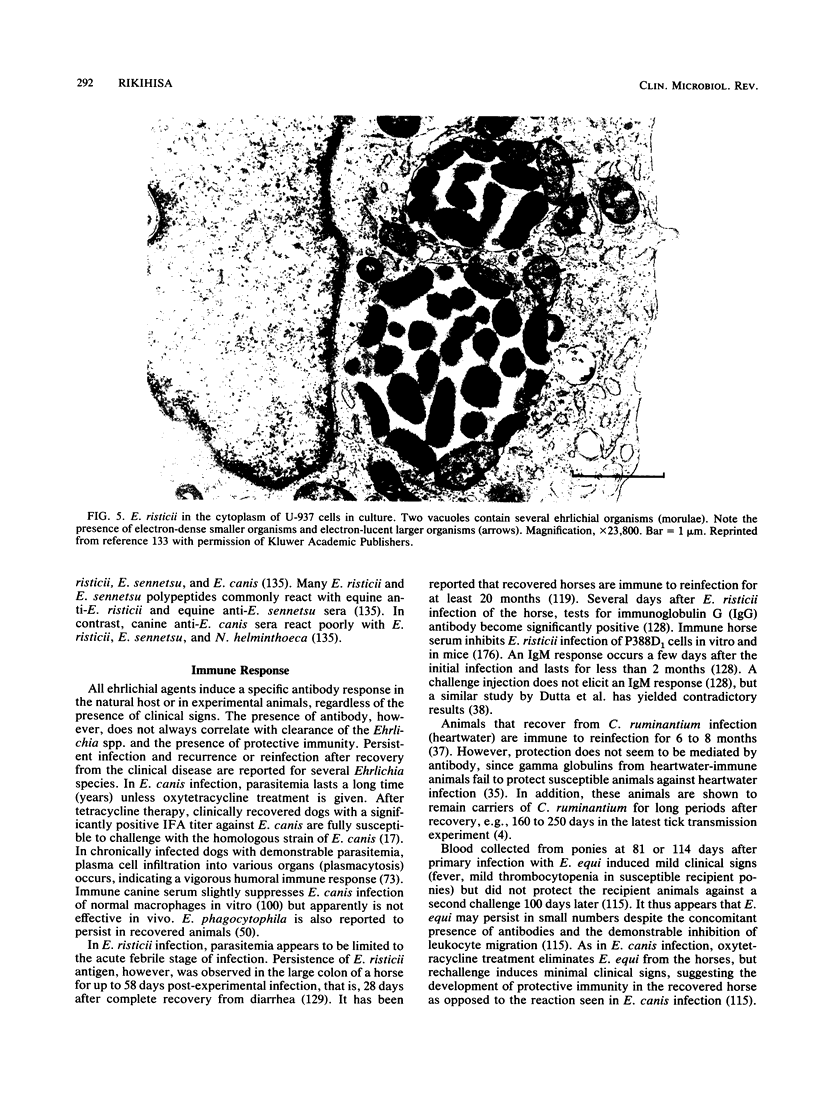
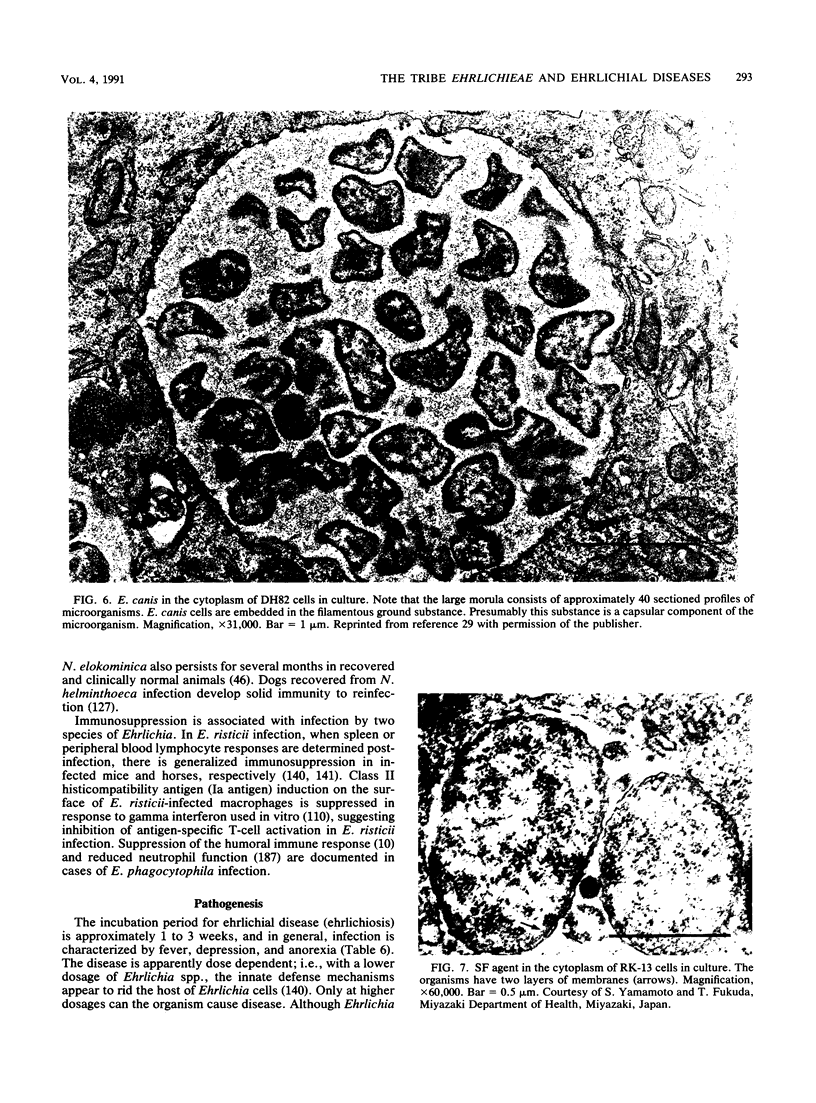
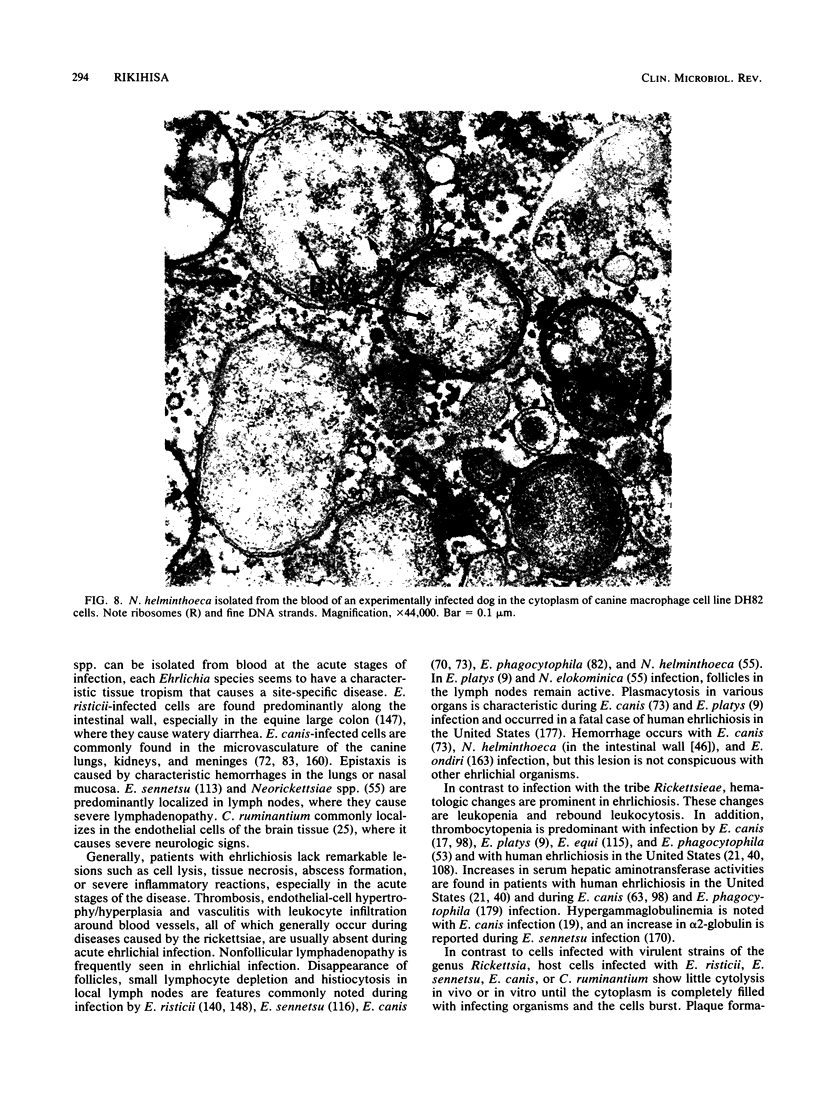
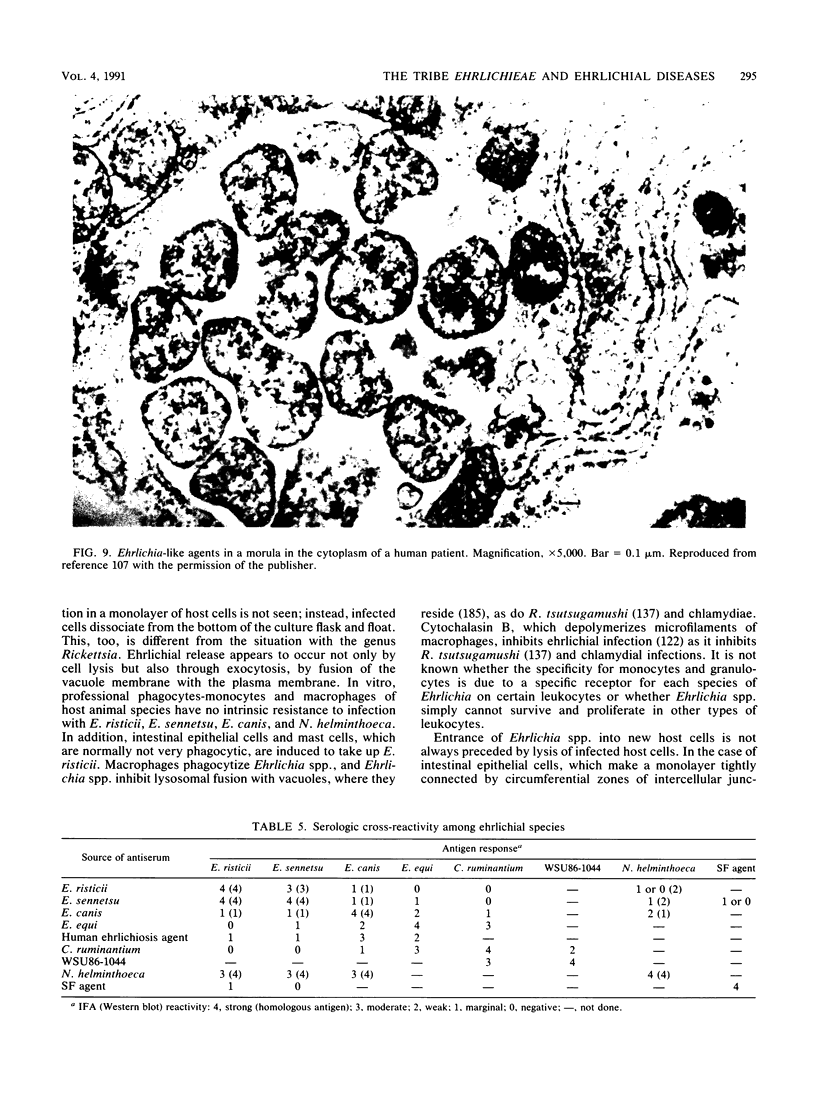
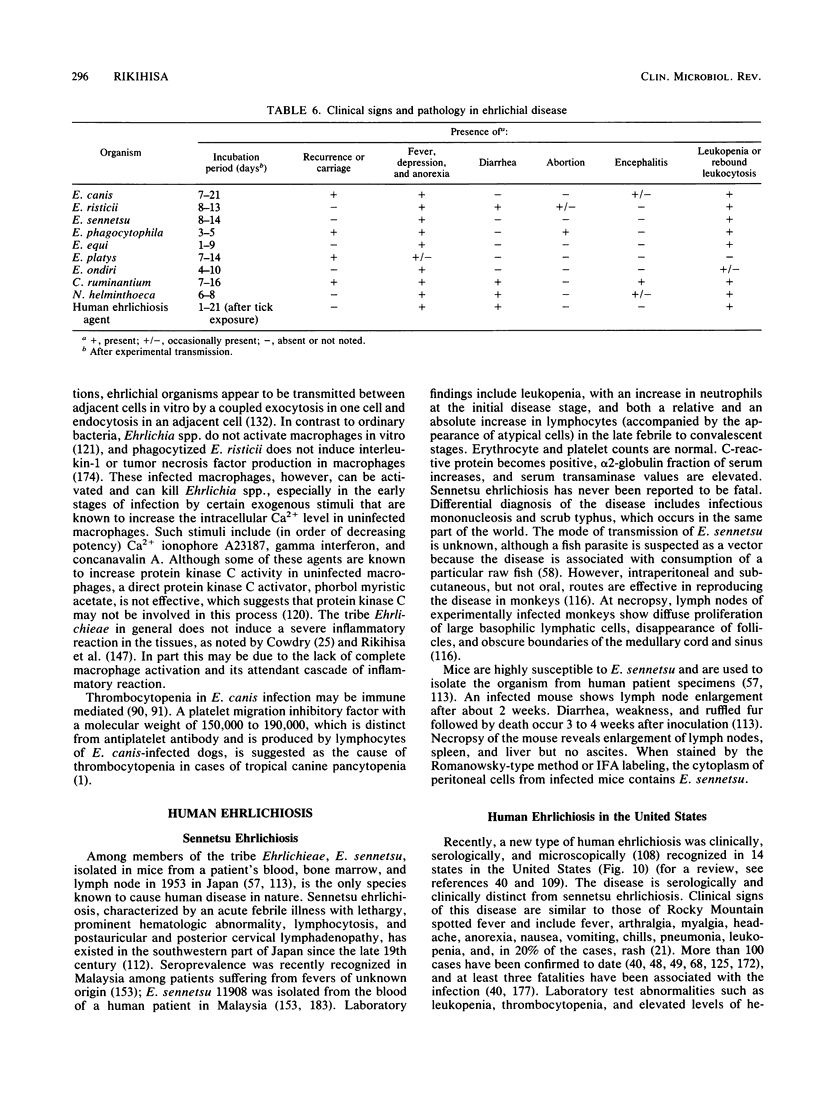
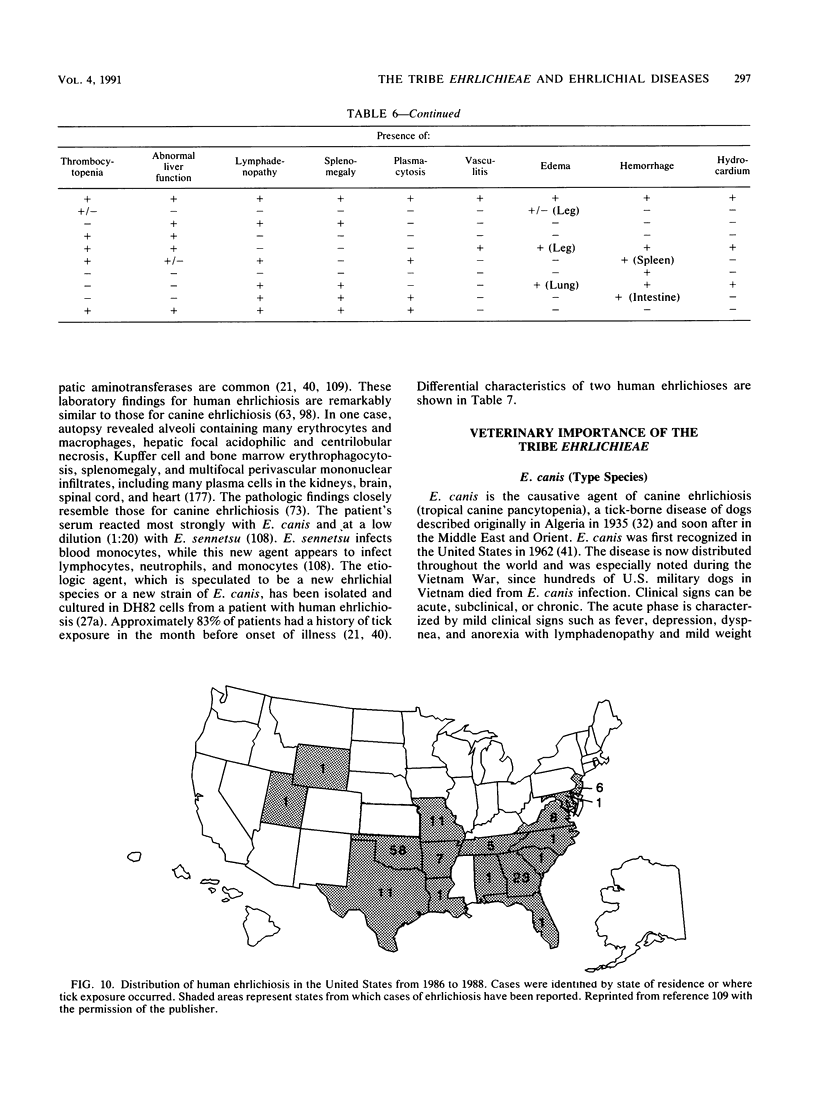
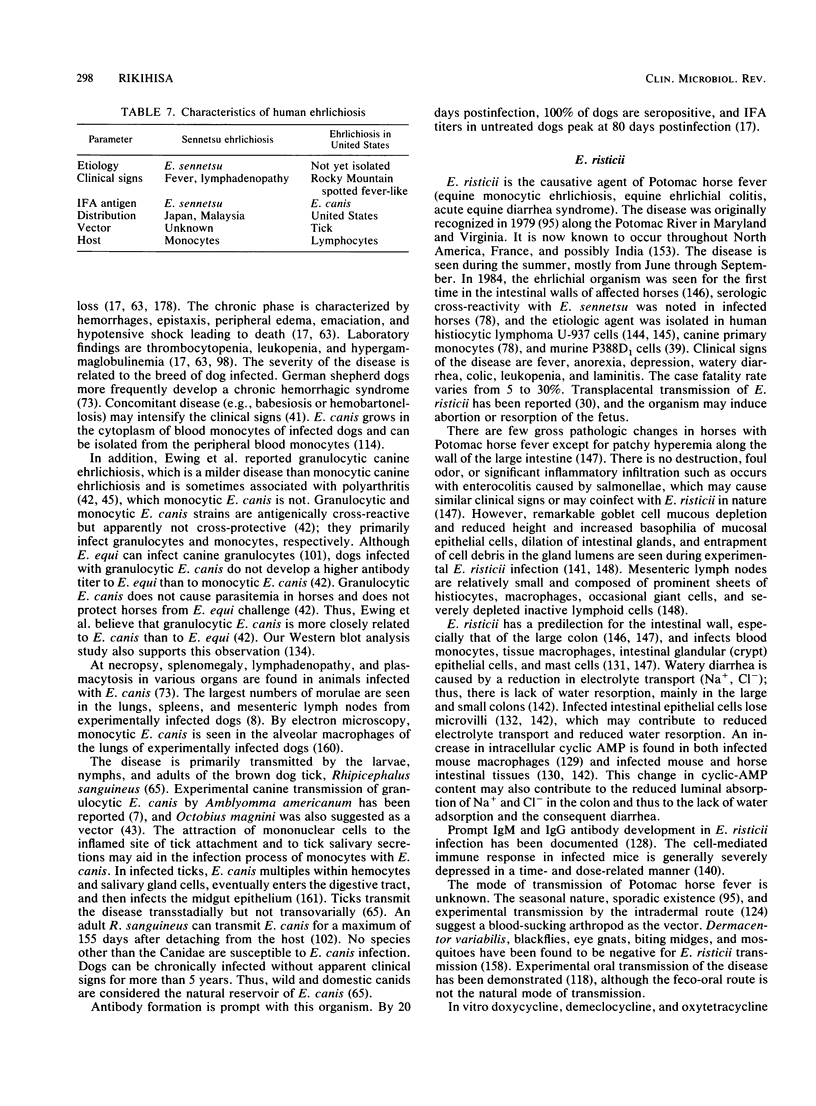
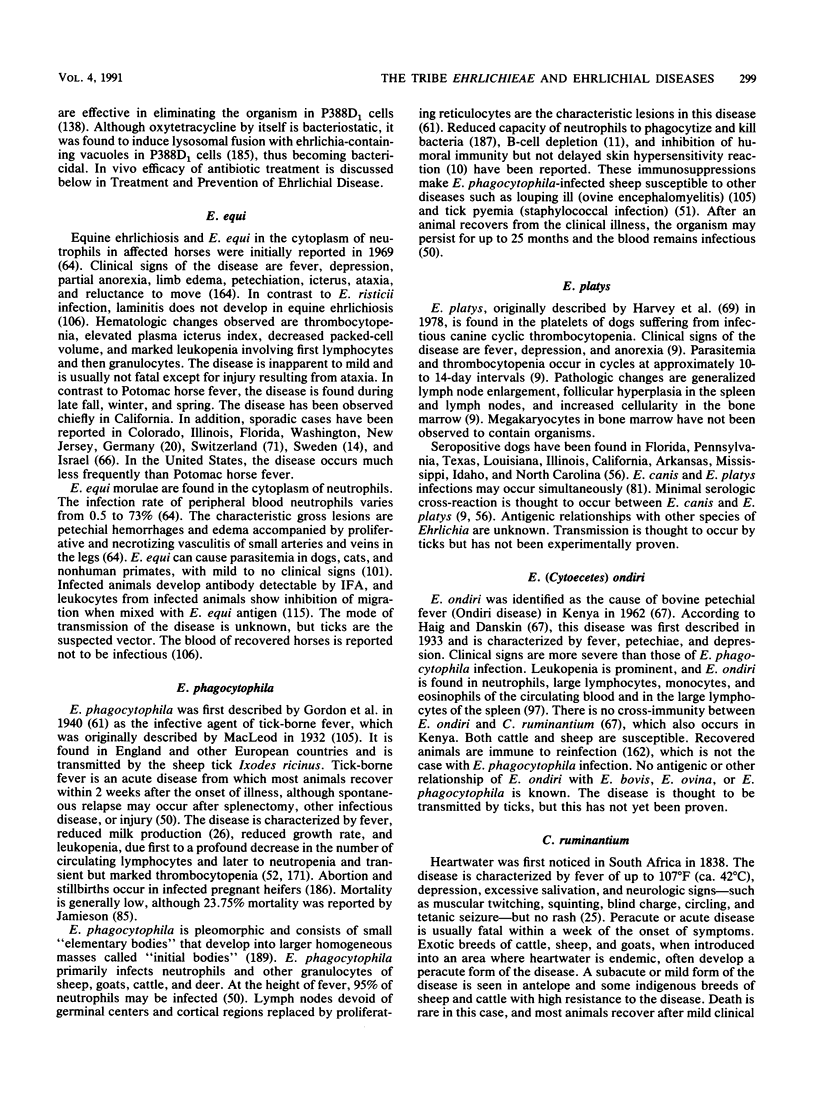
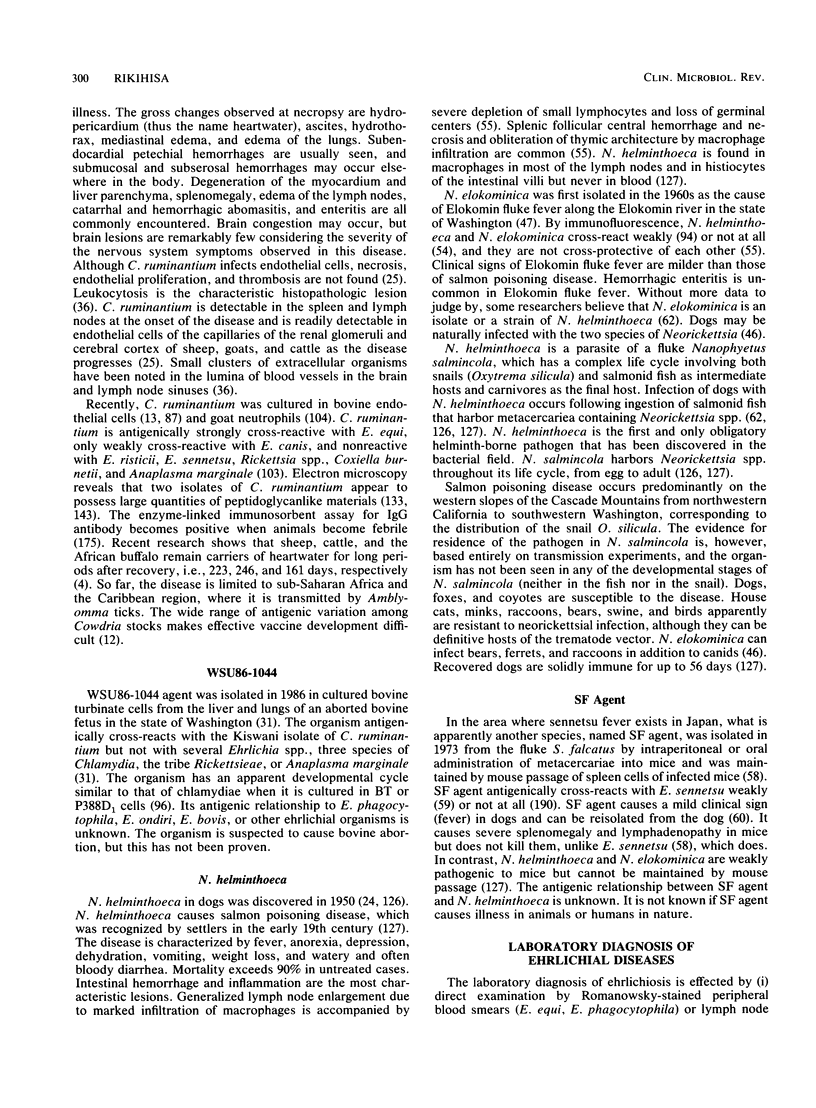
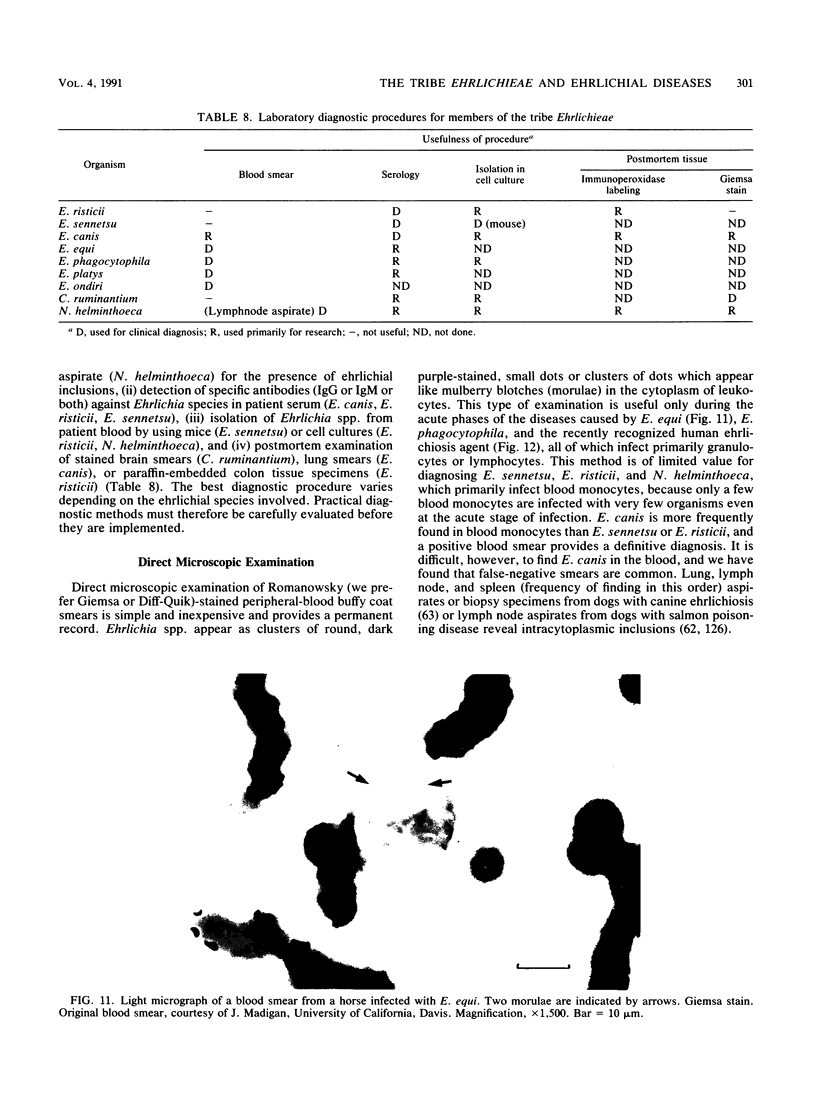
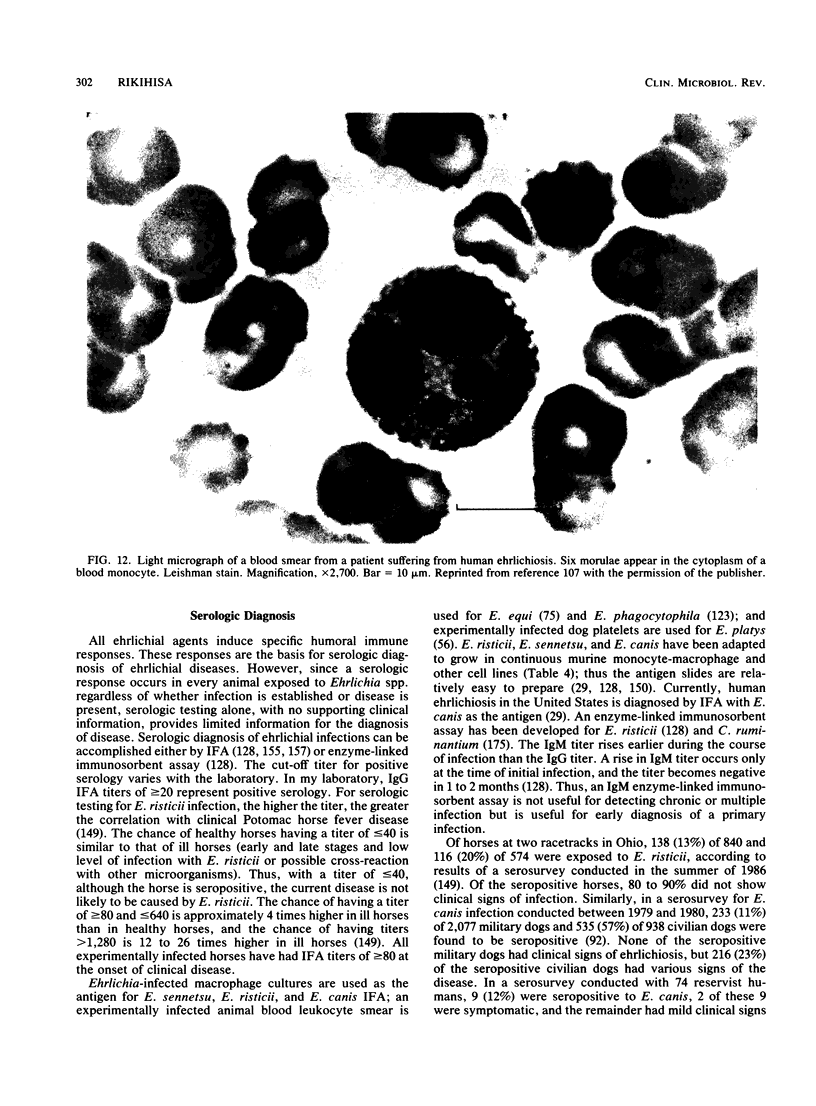
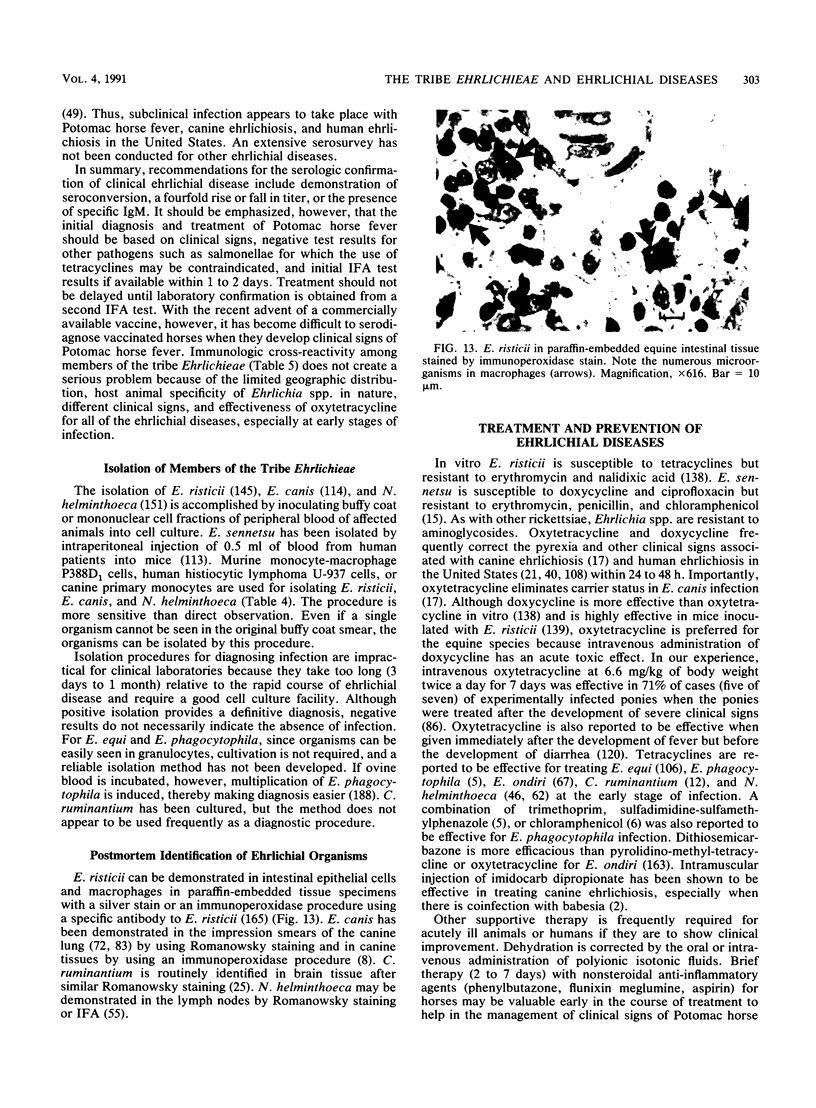
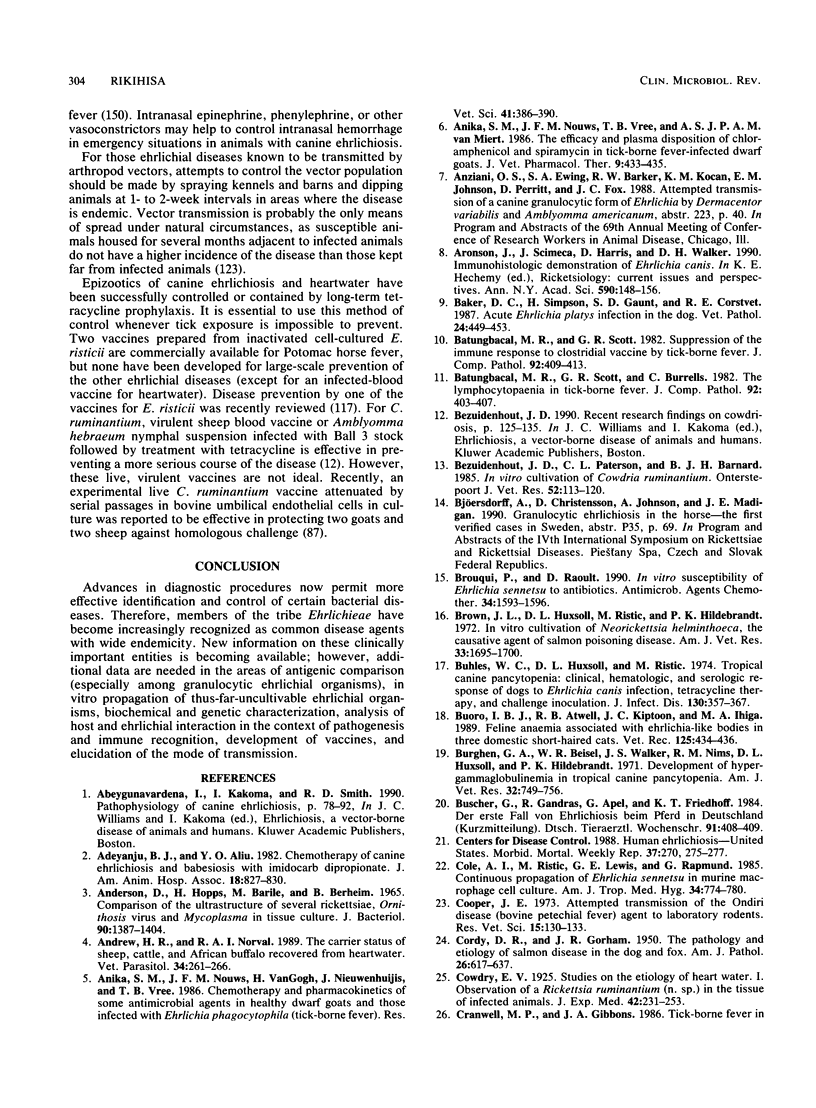
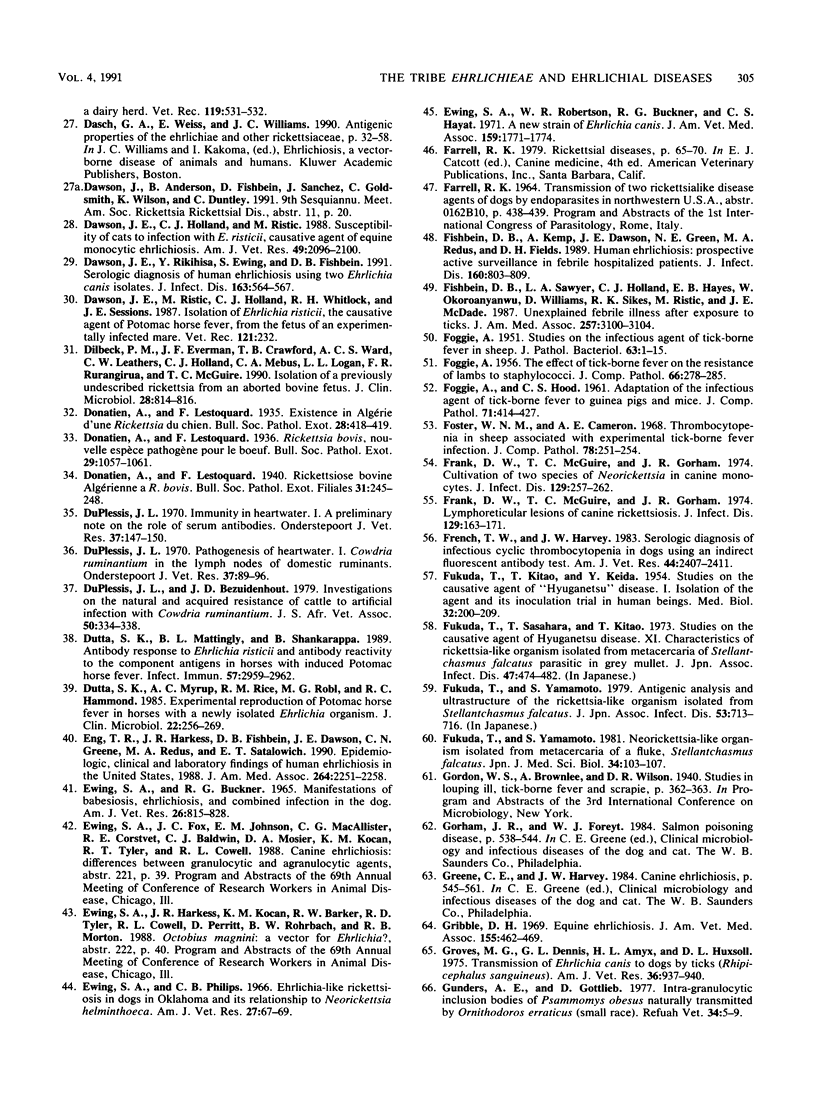
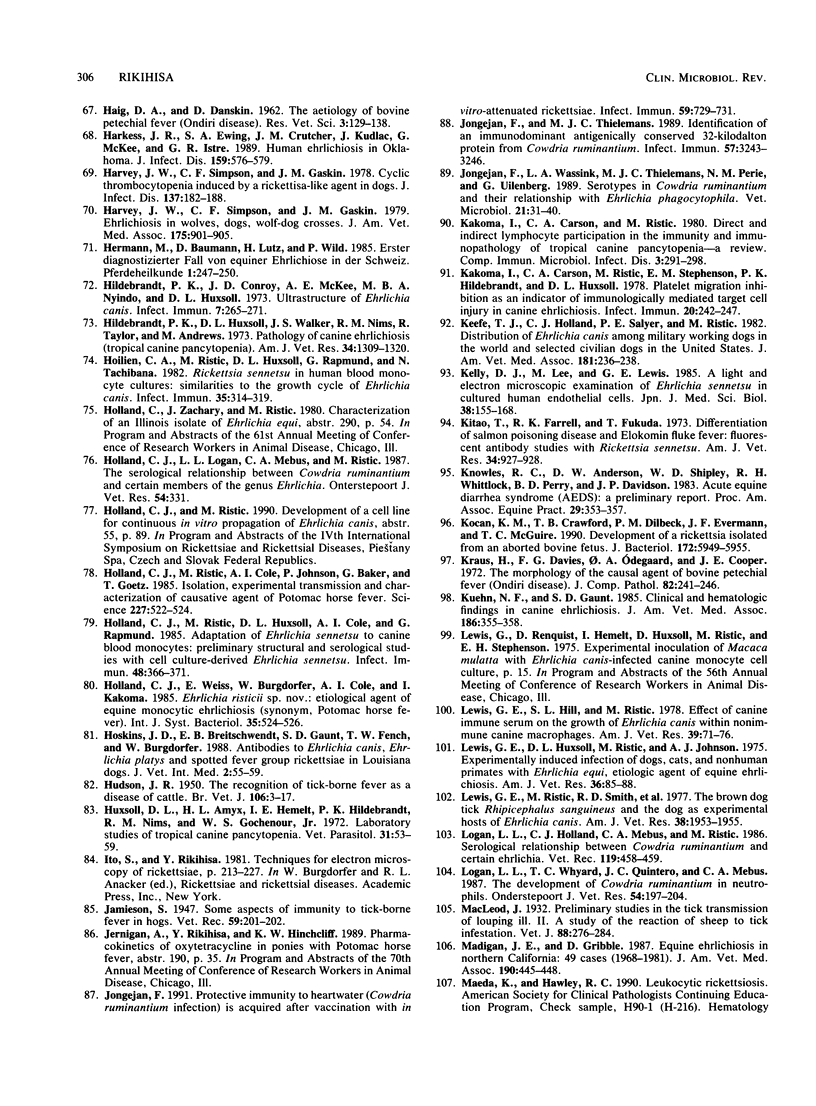
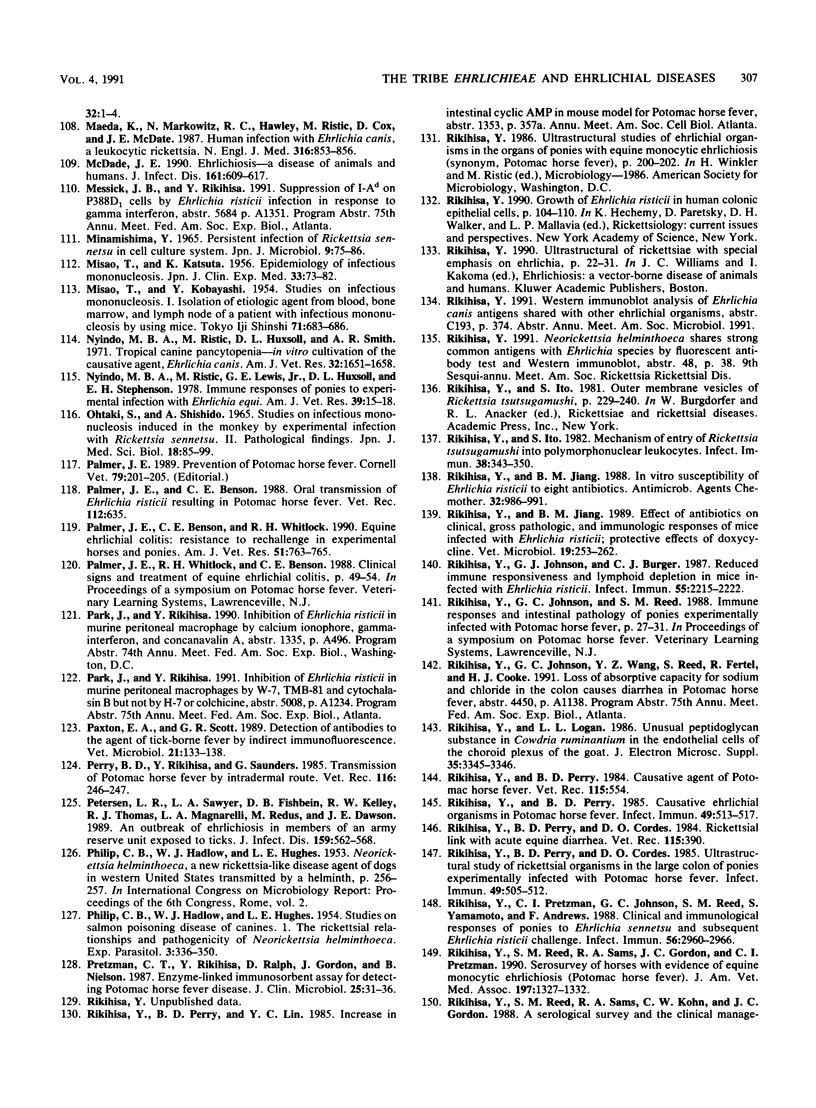
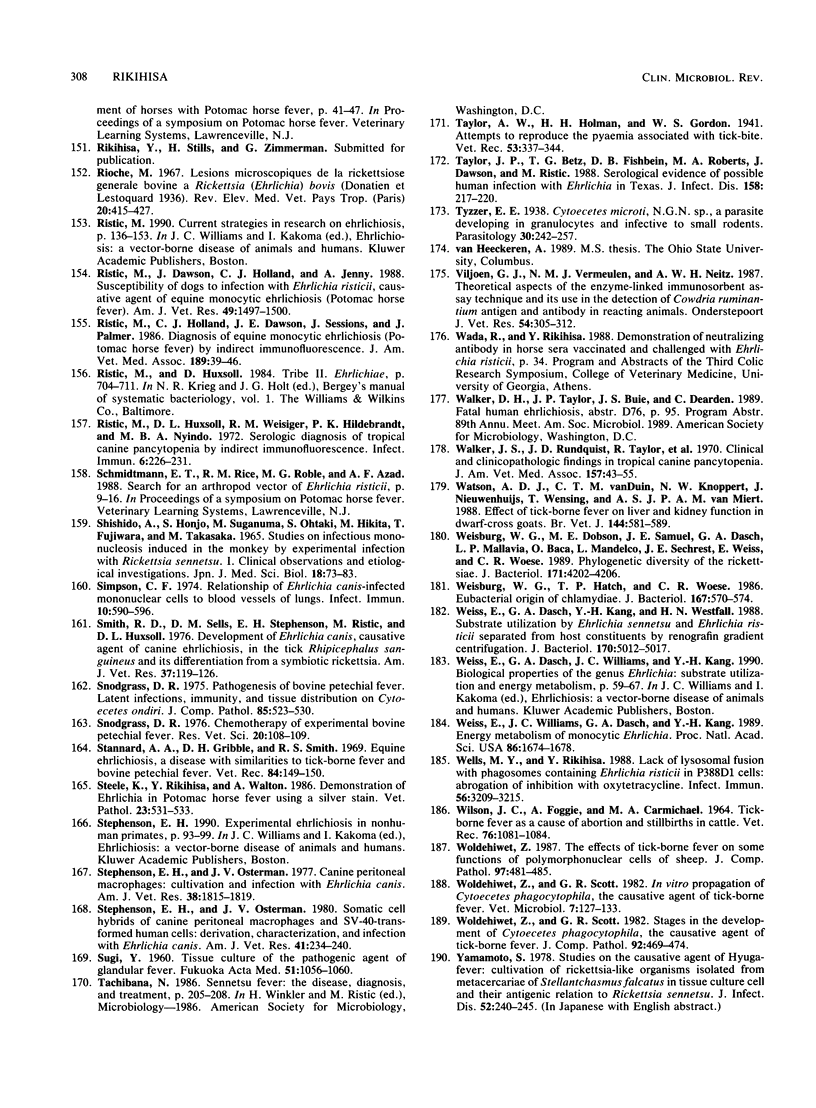
Images in this article
Selected References
These references are in PubMed. This may not be the complete list of references from this article.
- Anderson D. R., Hopps H. E., Barile M. F., Bernheim B. C. Comparison of the ultrastructure of several rickettsiae, ornithosis virus, and Mycoplasma in tissue culture. J Bacteriol. 1965 Nov;90(5):1387–1404. doi: 10.1128/jb.90.5.1387-1404.1965. [DOI] [PMC free article] [PubMed] [Google Scholar]
- Andrew H. R., Norval R. A. The carrier status of sheep, cattle and African buffalo recovered from heartwater. Vet Parasitol. 1989 Dec;34(3):261–266. doi: 10.1016/0304-4017(89)90056-3. [DOI] [PubMed] [Google Scholar]
- Anika S. M., Nouws J. F., Vree T. B., van Miert A. S. The efficacy and plasma disposition of chloramphenicol and spiramycin in tick-borne fever-infected dwarf goats. J Vet Pharmacol Ther. 1986 Dec;9(4):433–435. doi: 10.1111/j.1365-2885.1986.tb00064.x. [DOI] [PubMed] [Google Scholar]
- Anika S. M., Nouws J. F., van Gogh H., Nieuwenhuijs J., Vree T. B., van Miert A. S. Chemotherapy and pharmacokinetics of some antimicrobial agents in healthy dwarf goats and those infected with Ehrlichia phagocytophila (tick-borne fever). Res Vet Sci. 1986 Nov;41(3):386–390. [PubMed] [Google Scholar]
- Aronson J., Scimeca J., Harris D., Walker D. H. Immunohistologic demonstration of Ehrlichia canis. Ann N Y Acad Sci. 1990;590:148–156. doi: 10.1111/j.1749-6632.1990.tb42217.x. [DOI] [PubMed] [Google Scholar]
- Baker D. C., Simpson M., Gaunt S. D., Corstvet R. E. Acute Ehrlichia platys infection in the dog. Vet Pathol. 1987 Sep;24(5):449–453. doi: 10.1177/030098588702400513. [DOI] [PubMed] [Google Scholar]
- Batungbacal M. R., Scott G. R., Burrells C. The lymphocytopaenia in tick-borne fever. J Comp Pathol. 1982 Jul;92(3):403–407. doi: 10.1016/0021-9975(82)90026-3. [DOI] [PubMed] [Google Scholar]
- Batungbacal M. R., Scott G. R. Suppression of the immune response to clostridial vaccine by tick-borne fever. J Comp Pathol. 1982 Jul;92(3):409–413. doi: 10.1016/0021-9975(82)90027-5. [DOI] [PubMed] [Google Scholar]
- Bezuidenhout J. D., Paterson C. L., Barnard B. J. In vitro cultivation of Cowdria ruminantium. Onderstepoort J Vet Res. 1985 Jun;52(2):113–120. [PubMed] [Google Scholar]
- Brouqui P., Raoult D. In vitro susceptibility of Ehrlichia sennetsu to antibiotics. Antimicrob Agents Chemother. 1990 Aug;34(8):1593–1596. doi: 10.1128/aac.34.8.1593. [DOI] [PMC free article] [PubMed] [Google Scholar]
- Brown J. L., Huxsoll D. L., Ristic M., Hildebrandt P. K. In vitro cultivation of Neorickettsia helminthoeca, the causative agent of salmon poisoning disease. Am J Vet Res. 1972 Aug;33(8):1695–1700. [PubMed] [Google Scholar]
- Buhles W. C., Jr, Huxsoll D. L., Ristic M. Tropical canine pancytopenia: Clinical, hematologic, and serologic response of dogs to Ehrlichia canis infection, tetracycline therapy, and challenge inoculation. J Infect Dis. 1974 Oct;130(4):357–367. doi: 10.1093/infdis/130.4.357. [DOI] [PubMed] [Google Scholar]
- Buoro I. B., Atwell R. B., Kiptoon J. C., Ihiga M. A. Feline anaemia associated with Ehrlichia-like bodies in three domestic short-haired cats. Vet Rec. 1989 Oct 21;125(17):434–436. doi: 10.1136/vr.125.17.434. [DOI] [PubMed] [Google Scholar]
- Burghen G. A., Beisel W. R., Walker J. S., Nims R. M., Huxsoll D. L., Hildebrandt P. K. Development of hypergammaglobulinemia in tropical canine pancytopenia. Am J Vet Res. 1971 May;32(5):749–756. [PubMed] [Google Scholar]
- Büscher G., Gandras R., Apel G., Friedhoff K. T. Der erste Fall von Ehrlichiosis beim Pferd in Deutschland (Kurzmitteilung). Dtsch Tierarztl Wochenschr. 1984 Nov 22;91(11-12):408–409. [PubMed] [Google Scholar]
- CORDY D. R., GORHAM J. R. The pathology and etiology of salmon disease. Am J Pathol. 1950 Jul;26(4):617–637. [PMC free article] [PubMed] [Google Scholar]
- Causative agent of Potomac horse fever. Vet Rec. 1984 Nov 24;115(21):554–555. doi: 10.1136/vr.115.21.554. [DOI] [PubMed] [Google Scholar]
- Cole A. I., Ristic M., Lewis G. E., Jr, Rapmund G. Continuous propagation of Ehrlichia sennetsu in murine macrophage cell cultures. Am J Trop Med Hyg. 1985 Jul;34(4):774–780. doi: 10.4269/ajtmh.1985.34.774. [DOI] [PubMed] [Google Scholar]
- Cooper J. E. Attempted transmission of the Ondiri disease (Bovine Petechial Fever) agent to laboratory rodents. Res Vet Sci. 1973 Jul;15(1):130–133. [PubMed] [Google Scholar]
- Cranwell M. P., Gibbons J. A. Tick-borne fever in dairy herd. Vet Rec. 1986 Nov 22;119(21):531–532. doi: 10.1136/vr.119.21.531. [DOI] [PubMed] [Google Scholar]
- Dawson J. E., Abeygunawardena I., Holland C. J., Buese M. M., Ristic M. Susceptibility of cats to infection with Ehrlichia risticii, causative agent of equine monocytic ehrlichiosis. Am J Vet Res. 1988 Dec;49(12):2096–2100. [PubMed] [Google Scholar]
- Dawson J. E., Rikihisa Y., Ewing S. A., Fishbein D. B. Serologic diagnosis of human ehrlichiosis using two Ehrlichia canis isolates. J Infect Dis. 1991 Mar;163(3):564–567. doi: 10.1093/infdis/163.3.564. [DOI] [PubMed] [Google Scholar]
- Dawson J. E., Ristic M., Holland C. J., Whitlock R. H., Sessions J. Isolation of Ehrlichia risticii, the causative agent of Potomac horse fever, from the fetus of an experimentally infected mare. Vet Rec. 1987 Sep 5;121(10):232–232. doi: 10.1136/vr.121.10.232. [DOI] [PubMed] [Google Scholar]
- Dilbeck P. M., Evermann J. F., Crawford T. B., Ward A. C., Leathers C. W., Holland C. J., Mebus C. A., Logan L. L., Rurangirwa F. R., McGuire T. C. Isolation of a previously undescribed rickettsia from an aborted bovine fetus. J Clin Microbiol. 1990 Apr;28(4):814–816. doi: 10.1128/jcm.28.4.814-816.1990. [DOI] [PMC free article] [PubMed] [Google Scholar]
- Du Plessis J. L. Immunity in heartwater. I. A preliminary note on the role of serum antibodies. Onderstepoort J Vet Res. 1970 Sep;37(3):147–149. [PubMed] [Google Scholar]
- Du Plessis J. L. Pathogenesis of heartwater. I. Cowdria ruminantium in the lymph nodes of domestic ruminants. Onderstepoort J Vet Res. 1970 Jun;37(2):89–95. [PubMed] [Google Scholar]
- Dutta S. K., Mattingly B. L., Shankarappa B. Antibody response to Ehrlichia risticii and antibody reactivity to the component antigens in horses with induced Potomac horse fever. Infect Immun. 1989 Oct;57(10):2959–2962. doi: 10.1128/iai.57.10.2959-2962.1989. [DOI] [PMC free article] [PubMed] [Google Scholar]
- Dutta S. K., Myrup A. C., Rice R. M., Robl M. G., Hammond R. C. Experimental reproduction of Potomac horse fever in horses with a newly isolated Ehrlichia organism. J Clin Microbiol. 1985 Aug;22(2):265–269. doi: 10.1128/jcm.22.2.265-269.1985. [DOI] [PMC free article] [PubMed] [Google Scholar]
- Eng T. R., Harkess J. R., Fishbein D. B., Dawson J. E., Greene C. N., Redus M. A., Satalowich F. T. Epidemiologic, clinical, and laboratory findings of human ehrlichiosis in the United States, 1988. JAMA. 1990 Nov 7;264(17):2251–2258. [PubMed] [Google Scholar]
- Ewing S. A., Buckner R. G. Manifestations of babesiosis, ehrlichiosis, and combined infections in the dog. Am J Vet Res. 1965 Jul;26(113):815–828. [PubMed] [Google Scholar]
- Ewing S. A., Philip C. B. Ehrlichia-like rickettsiosis in dogs in Oklahoma and its relationship to Neorickettsia helminthoeca. Am J Vet Res. 1966 Jan;27(116):67–69. [PubMed] [Google Scholar]
- Ewing S. A., Roberson W. R., Buckner R. G., Hayat C. S. A new strain of Ehrlichia canis. J Am Vet Med Assoc. 1971 Dec 15;159(12):1771–1774. [PubMed] [Google Scholar]
- FOGGIE A., HOOD C. S. Adaptation of the infectious agent of tick-borne fever to guinea-pigs and mice. J Comp Pathol. 1961 Oct;71:414–427. doi: 10.1016/s0368-1742(61)80046-5. [DOI] [PubMed] [Google Scholar]
- FOGGIE A. Studies on the infectious agent of tick-borne fever in sheep. J Pathol Bacteriol. 1951 Jan;63(1):1–15. doi: 10.1002/path.1700630103. [DOI] [PubMed] [Google Scholar]
- FOGGIE A. The effect of thick-borne fever on the resistance of lambs to staphylococci. J Comp Pathol. 1956 Jul;66(3):278–285. doi: 10.1016/s0368-1742(56)80029-5. [DOI] [PubMed] [Google Scholar]
- Fishbein D. B., Kemp A., Dawson J. E., Greene N. R., Redus M. A., Fields D. H. Human ehrlichiosis: prospective active surveillance in febrile hospitalized patients. J Infect Dis. 1989 Nov;160(5):803–809. doi: 10.1093/infdis/160.5.803. [DOI] [PubMed] [Google Scholar]
- Fishbein D. B., Sawyer L. A., Holland C. J., Hayes E. B., Okoroanyanwu W., Williams D., Sikes K., Ristic M., McDade J. E. Unexplained febrile illnesses after exposure to ticks. Infection with an Ehrlichia? JAMA. 1987 Jun 12;257(22):3100–3104. [PubMed] [Google Scholar]
- Foster W. N., Cameron A. E. Thrombocytopenia in sheep associated with experimental tick-borne fever infection. J Comp Pathol. 1968 Apr;78(2):251–254. doi: 10.1016/0021-9975(68)90102-3. [DOI] [PubMed] [Google Scholar]
- Frank D. W., McGuire T. C., Gorham J. R., Davis W. C. Cultivation of two species of Neorickettsia in canine monocytes. J Infect Dis. 1974 Mar;129(3):257–262. doi: 10.1093/infdis/129.3.257. [DOI] [PubMed] [Google Scholar]
- Frank D. W., McGuire T. C., Gorham J. R., Farrell R. K. Lymphoreticular lesions of canine neorickettsiosis. J Infect Dis. 1974 Feb;129(2):163–171. doi: 10.1093/infdis/129.2.163. [DOI] [PubMed] [Google Scholar]
- French T. W., Harvey J. W. Serologic diagnosis of infectious cyclic thrombocytopenia in dogs using an indirect fluorescent antibody test. Am J Vet Res. 1983 Dec;44(12):2407–2411. [PubMed] [Google Scholar]
- Fukuda T., Sasahara T., Kitao T. [Causative agent of "Hyuganetsu" disease. 11. Characteristics of rickettsia-like organisms isolated from metacercaria of Stellantchasmus falcatus]. Kansenshogaku Zasshi. 1973 Dec;47(12):474–482. doi: 10.11150/kansenshogakuzasshi1970.47.474. [DOI] [PubMed] [Google Scholar]
- Fukuda T., Yamamoto S. Neorickettsia-like organism isolated from metacercaria of a fluke, Stellantchasmus falcatus. Jpn J Med Sci Biol. 1981 Apr;34(2):103–107. doi: 10.7883/yoken1952.34.103. [DOI] [PubMed] [Google Scholar]
- Fukuda T., Yamamoto S. [Antigenic analysis and ultrastructure of the Rickettsia-like organism isolated from Stellantchasmus falcatus (author's transl)]. Kansenshogaku Zasshi. 1979 Dec;53(12):713–716. doi: 10.11150/kansenshogakuzasshi1970.53.713. [DOI] [PubMed] [Google Scholar]
- Gribble D. H. Equine ehrlichiosis. J Am Vet Med Assoc. 1969 Jul 15;155(2):462–469. [PubMed] [Google Scholar]
- Groves M. G., Dennis G. L., Amyx H. L., Huxsoll D. L. Transmission of Ehrlichia canis to dogs by ticks (Rhipicephalus sanguineus). Am J Vet Res. 1975 Jul;36(7):937–940. [PubMed] [Google Scholar]
- Harkess J. R., Ewing S. A., Crutcher J. M., Kudlac J., McKee G., Istre G. R. Human ehrlichiosis in Oklahoma. J Infect Dis. 1989 Mar;159(3):576–579. doi: 10.1093/infdis/159.3.576. [DOI] [PubMed] [Google Scholar]
- Harvey J. W., Simpson C. F., Gaskin J. M. Cyclic thrombocytopenia induced by a Rickettsia-like agent in dogs. J Infect Dis. 1978 Feb;137(2):182–188. doi: 10.1093/infdis/137.2.182. [DOI] [PubMed] [Google Scholar]
- Harvey J. W., Simpson C. F., Gaskin J. M., Sameck J. H. Ehrlichiosis in wolves, dogs, and wolf-dog crosses. J Am Vet Med Assoc. 1979 Nov 1;175(9):901–905. [PubMed] [Google Scholar]
- Hildebrandt P. K., Conroy J. D., McKee A. E., Nyindo M. B., Huxsoll D. L. Ultrastructure of Ehrlichia canis. Infect Immun. 1973 Feb;7(2):265–271. doi: 10.1128/iai.7.2.265-271.1973. [DOI] [PMC free article] [PubMed] [Google Scholar]
- Hildebrandt P. K., Huxsoll D. L., Walker J. S., Nims R. M., Taylor R., Andrews M. Pathology of canine ehrlichiosis (tropical canine pancytopenia). Am J Vet Res. 1973 Oct;34(10):1309–1320. [PubMed] [Google Scholar]
- Hoilien C. A., Ristic M., Huxsoll D. L., Rapmund G. Rickettsia sennetsu in human blood monocyte cultures: similarities to the growth cycle of Ehrlichia canis. Infect Immun. 1982 Jan;35(1):314–319. doi: 10.1128/iai.35.1.314-319.1982. [DOI] [PMC free article] [PubMed] [Google Scholar]
- Holland C. J., Ristic M., Cole A. I., Johnson P., Baker G., Goetz T. Isolation, experimental transmission, and characterization of causative agent of Potomac horse fever. Science. 1985 Feb 1;227(4686):522–524. doi: 10.1126/science.3880925. [DOI] [PubMed] [Google Scholar]
- Holland C. J., Ristic M., Huxsoll D. L., Cole A. I., Rapmund G. Adaptation of Ehrlichia sennetsu to canine blood monocytes: preliminary structural and serological studies with cell culture-derived Ehrlichia sennetsu. Infect Immun. 1985 May;48(2):366–371. doi: 10.1128/iai.48.2.366-371.1985. [DOI] [PMC free article] [PubMed] [Google Scholar]
- Hoskins J. D., Breitschwerdt E. B., Gaunt S. D., French T. W., Burgdorfer W. Antibodies to Ehrlichia canis, Ehrlichia platys, and spotted fever group rickettsiae in Louisiana dogs. J Vet Intern Med. 1988 Apr-Jun;2(2):55–59. doi: 10.1111/j.1939-1676.1988.tb02793.x. [DOI] [PubMed] [Google Scholar]
- Huxsoll D. L., Amyx H. L., Hemelt I. E., Hildebrandt P. K., Nims R. M., Gochenour W. S., Jr Laboratory studies of tropical canine pancytopenia. Exp Parasitol. 1972 Feb;31(1):53–59. doi: 10.1016/0014-4894(72)90046-x. [DOI] [PubMed] [Google Scholar]
- Jongejan F. Protective immunity to heartwater (Cowdria ruminantium infection) is acquired after vaccination with in vitro-attenuated rickettsiae. Infect Immun. 1991 Feb;59(2):729–731. doi: 10.1128/iai.59.2.729-731.1991. [DOI] [PMC free article] [PubMed] [Google Scholar]
- Jongejan F., Thielemans M. J. Identification of an immunodominant antigenically conserved 32-kilodalton protein from Cowdria ruminantium. Infect Immun. 1989 Oct;57(10):3243–3246. doi: 10.1128/iai.57.10.3243-3246.1989. [DOI] [PMC free article] [PubMed] [Google Scholar]
- Jongejan F., Wassink L. A., Thielemans M. J., Perie N. M., Uilenberg G. Serotypes in Cowdria ruminantium and their relationship with Ehrlichia phagocytophila determined by immunofluorescence. Vet Microbiol. 1989 Nov;21(1):31–40. doi: 10.1016/0378-1135(89)90016-3. [DOI] [PubMed] [Google Scholar]
- Kakoma I., Carson C. A., Ristic M. Direct and indirect lymphocyte participation in the immunity and immunopathology of tropical canine pancytopenia--a review. Comp Immunol Microbiol Infect Dis. 1980;3(3):291–298. doi: 10.1016/0147-9571(80)90005-3. [DOI] [PubMed] [Google Scholar]
- Kakoma I., Carson C. A., Ristic M., Stephenson E. M., Hildebrandt P. K., Huxsoll D. L. Platelet migration inhibtion as an indicator of immunologically mediated target cell injury in canine ehrlichiosis. Infect Immun. 1978 Apr;20(1):242–247. doi: 10.1128/iai.20.1.242-247.1978. [DOI] [PMC free article] [PubMed] [Google Scholar]
- Keefe T. J., Holland C. J., Salyer P. E., Ristic M. Distribution of Ehrlichia canis among military working dogs in the world and selected civilian dogs in the United States. J Am Vet Med Assoc. 1982 Aug 1;181(3):236–238. [PubMed] [Google Scholar]
- Kelly D. J., Lee M., Lewis G. E., Jr A light and electron microscopic examination of Ehrlichia sennetsu in cultured human endothelial cells. Jpn J Med Sci Biol. 1985 Aug;38(4):155–168. doi: 10.7883/yoken1952.38.155. [DOI] [PubMed] [Google Scholar]
- Kitao T., Farrell R. K., Fukuda T. Differentiation of salmon poisoning disease and Elokomin fluke fever: fluorescent antibody studies with Rickettsia sennetsu? Am J Vet Res. 1973 Jul;34(7):927–928. [PubMed] [Google Scholar]
- Kocan K. M., Crawford T. B., Dilbeck P. M., Evermann J. F., McGuire T. C. Development of a rickettsia isolated from an aborted bovine fetus. J Bacteriol. 1990 Oct;172(10):5949–5955. doi: 10.1128/jb.172.10.5949-5955.1990. [DOI] [PMC free article] [PubMed] [Google Scholar]
- Krauss H., Davies F. G., Odegaard O. A., Cooper J. E. The morphology of the causal agent of bovine petechial fever (Ondiri disease). J Comp Pathol. 1972 Jul;82(3):241–246. doi: 10.1016/0021-9975(72)90002-3. [DOI] [PubMed] [Google Scholar]
- Kuehn N. F., Gaunt S. D. Clinical and hematologic findings in canine ehrlichiosis. J Am Vet Med Assoc. 1985 Feb 15;186(4):355–358. [PubMed] [Google Scholar]
- Lewis G. E., Jr, Hill S. L., Ristic M. Effect of canine immune serum on the growth of Ehrlichia canis within nonimmune canine macrophages. Am J Vet Res. 1978 Jan;39(1):71–76. [PubMed] [Google Scholar]
- Lewis G. E., Jr, Huxsoll D. L., Ristic M., Johnson A. J. Experimentally induced infection of dogs, cats, and nonhuman primates with Ehrlichia equi, etiologic agent of equine ehrlichiosis. Am J Vet Res. 1975 Jan;36(1):85–88. [PubMed] [Google Scholar]
- Lewis G. E., Jr, Ristic M., Smith R. D., Lincoln T., Stephenson E. H. The brown dog tick Rhipicephalus sanguineus and the dog as experimental hosts of Ehrlichia canis. Am J Vet Res. 1977 Dec;38(12):1953–1955. [PubMed] [Google Scholar]
- Logan L. L., Holland C. J., Mebus C. A., Ristic M. Serological relationship between Cowdria ruminantium and certain ehrlichia. Vet Rec. 1986 Nov 1;119(18):458–459. doi: 10.1136/vr.119.18.458. [DOI] [PubMed] [Google Scholar]
- Logan L. L., Whyard T. C., Quintero J. C., Mebus C. A. The development of Cowdria ruminantium in neutrophils. Onderstepoort J Vet Res. 1987 Sep;54(3):197–204. [PubMed] [Google Scholar]
- Madigan J. E., Gribble D. Equine ehrlichiosis in northern California: 49 cases (1968-1981). J Am Vet Med Assoc. 1987 Feb 15;190(4):445–448. [PubMed] [Google Scholar]
- Maeda K., Markowitz N., Hawley R. C., Ristic M., Cox D., McDade J. E. Human infection with Ehrlichia canis, a leukocytic rickettsia. N Engl J Med. 1987 Apr 2;316(14):853–856. doi: 10.1056/NEJM198704023161406. [DOI] [PubMed] [Google Scholar]
- McDade J. E. Ehrlichiosis--a disease of animals and humans. J Infect Dis. 1990 Apr;161(4):609–617. doi: 10.1093/infdis/161.4.609. [DOI] [PubMed] [Google Scholar]
- Minamishima Y. Persistent infection of Rickettsia sennetsu in cell culture system. Jpn J Microbiol. 1965 Jun;9(2):75–86. doi: 10.1111/j.1348-0421.1965.tb00277.x. [DOI] [PubMed] [Google Scholar]
- Nyindo M. B., Ristic M., Huxsoll D. L., Smith A. R. Tropical canine pancytopenia: in vitro cultivation of the causative agent--Ehrlichia canis. Am J Vet Res. 1971 Nov;32(11):1651–1658. [PubMed] [Google Scholar]
- Nyindo M. B., Ristic M., Lewis G. E., Jr, Huxsoll D. L., Stephenson E. H. Immune response of ponies to experimental infection with Ehrlichia equi. Am J Vet Res. 1978 Jan;39(1):15–18. [PubMed] [Google Scholar]
- OHTAKI S., SHISHIDO A. STUDIES ON INFECTIOUS MONONUCLEOSIS INDUCED IN THE MONKEY BY EXPERIMENTAL INFECTION WITH RICKETTSIA SENNETSU. II. PATHOLOGICAL FINDINGS. Jpn J Med Sci Biol. 1965 Apr;18:85–100. doi: 10.7883/yoken1952.18.85. [DOI] [PubMed] [Google Scholar]
- PHILIP C. B., HADLOW W. J., HUGHES L. E. Studies on salmon poisoning disease of canines. I. The rickettsial relationships and pathogenicity of Neorickettsia helmintheca. Exp Parasitol. 1954 Jul;3(4):336–350. doi: 10.1016/0014-4894(54)90032-6. [DOI] [PubMed] [Google Scholar]
- Palmer J. E., Benson C. E. Oral transmission of Ehrlichia risticii resulting in Potomac horse fever. Vet Rec. 1988 Jun 25;122(26):635–635. doi: 10.1136/vr.122.26.635. [DOI] [PubMed] [Google Scholar]
- Palmer J. E., Benson C. E., Whitlock R. H. Resistance to development of equine ehrlichial colitis in experimentally inoculated horses and ponies. Am J Vet Res. 1990 May;51(5):763–765. [PubMed] [Google Scholar]
- Palmer J. E. Prevention of Potomac horse fever. Cornell Vet. 1989 Jul;79(3):201–205. [PubMed] [Google Scholar]
- Paxton E. A., Scott G. R. Detection of antibodies to the agent of tick-borne fever by indirect immunofluorescence. Vet Microbiol. 1989 Dec;21(2):133–138. doi: 10.1016/0378-1135(89)90025-4. [DOI] [PubMed] [Google Scholar]
- Perry B. D., Rikihisa Y., Saunders G. K. Intradermal transmission of Potomac horse fever. Vet Rec. 1985 Mar 2;116(9):246–247. doi: 10.1136/vr.116.9.246. [DOI] [PubMed] [Google Scholar]
- Petersen L. R., Sawyer L. A., Fishbein D. B., Kelley P. W., Thomas R. J., Magnarelli L. A., Redus M., Dawson J. E. An outbreak of ehrlichiosis in members of an Army Reserve unit exposed to ticks. J Infect Dis. 1989 Mar;159(3):562–568. doi: 10.1093/infdis/159.3.562. [DOI] [PubMed] [Google Scholar]
- Pretzman C. I., Rikihisa Y., Ralph D., Gordon J. C., Bech-Nielsen S. Enzyme-linked immunosorbent assay for Potomac horse fever disease. J Clin Microbiol. 1987 Jan;25(1):31–36. doi: 10.1128/jcm.25.1.31-36.1987. [DOI] [PMC free article] [PubMed] [Google Scholar]
- Rikihisa Y. Growth of Ehrlichia risticii in human colonic epithelial cells. Ann N Y Acad Sci. 1990;590:104–110. doi: 10.1111/j.1749-6632.1990.tb42212.x. [DOI] [PubMed] [Google Scholar]
- Rikihisa Y., Ito S. Entry of Rickettsia tsutsugamushi into polymorphonuclear leukocytes. Infect Immun. 1982 Oct;38(1):343–350. doi: 10.1128/iai.38.1.343-350.1982. [DOI] [PMC free article] [PubMed] [Google Scholar]
- Rikihisa Y., Jiang B. M. Effect of antibiotics on clinical, pathologic and immunologic responses in murine Potomac horse fever: protective effects of doxycycline. Vet Microbiol. 1989 Mar;19(3):253–262. doi: 10.1016/0378-1135(89)90071-0. [DOI] [PubMed] [Google Scholar]
- Rikihisa Y., Jiang B. M. In vitro susceptibilities of Ehrlichia risticii to eight antibiotics. Antimicrob Agents Chemother. 1988 Jul;32(7):986–991. doi: 10.1128/aac.32.7.986. [DOI] [PMC free article] [PubMed] [Google Scholar]
- Rikihisa Y., Johnson G. C., Burger C. J. Reduced immune responsiveness and lymphoid depletion in mice infected with Ehrlichia risticii. Infect Immun. 1987 Sep;55(9):2215–2222. doi: 10.1128/iai.55.9.2215-2222.1987. [DOI] [PMC free article] [PubMed] [Google Scholar]
- Rikihisa Y., Perry B. D. Causative ehrlichial organisms in Potomac horse fever. Infect Immun. 1985 Sep;49(3):513–517. doi: 10.1128/iai.49.3.513-517.1985. [DOI] [PMC free article] [PubMed] [Google Scholar]
- Rikihisa Y., Perry B. D., Cordes D. O. Ultrastructural study of ehrlichial organisms in the large colons of ponies infected with Potomac horse fever. Infect Immun. 1985 Sep;49(3):505–512. doi: 10.1128/iai.49.3.505-512.1985. [DOI] [PMC free article] [PubMed] [Google Scholar]
- Rikihisa Y., Perry B., Cordes D. Rickettsial link with acute equine diarrhoea. Vet Rec. 1984 Oct 13;115(15):390–390. doi: 10.1136/vr.115.15.390-a. [DOI] [PubMed] [Google Scholar]
- Rikihisa Y., Pretzman C. I., Johnson G. C., Reed S. M., Yamamoto S., Andrews F. Clinical, histopathological, and immunological responses of ponies to Ehrlichia sennetsu and subsequent Ehrlichia risticii challenge. Infect Immun. 1988 Nov;56(11):2960–2966. doi: 10.1128/iai.56.11.2960-2966.1988. [DOI] [PMC free article] [PubMed] [Google Scholar]
- Rikihisa Y., Reed S. M., Sams R. A., Gordon J. C., Pretzman C. I. Serosurvey of horses with evidence of equine monocytic ehrlichiosis. J Am Vet Med Assoc. 1990 Nov 15;197(10):1327–1332. [PubMed] [Google Scholar]
- Rioche M. Lésions microscopiques de la rickettsiose générale bovine à Rickettsia (Erlichia) bovis (Donatien et Lestoquard 1936) Rev Elev Med Vet Pays Trop. 1967;20(3):415–427. doi: 10.19182/remvt.7476. [DOI] [PubMed] [Google Scholar]
- Ristic M., Dawson J., Holland C. J., Jenny A. Susceptibility of dogs to infection with Ehrlichia risticii, causative agent of equine monocytic ehrlichiosis (Potomac horse fever). Am J Vet Res. 1988 Sep;49(9):1497–1500. [PubMed] [Google Scholar]
- Ristic M., Holland C. J., Dawson J. E., Sessions J., Palmer J. Diagnosis of equine monocytic ehrlichiosis (Potomac horse fever) by indirect immunofluorescence. J Am Vet Med Assoc. 1986 Jul 1;189(1):39–46. [PubMed] [Google Scholar]
- Ristic M., Huxsoll D. L., Weisiger R. M., Hildebrandt P. K., Nyindo M. B. Serological diagnosis of tropical canine pancytopenia by indirect immunofluorescence. Infect Immun. 1972 Sep;6(3):226–231. doi: 10.1128/iai.6.3.226-231.1972. [DOI] [PMC free article] [PubMed] [Google Scholar]
- SHISHIDO A., HONJO S., SUGANUMA M., OHTAKI S., HIKITA M., FUJIWARA T., TAKASAKA M. STUDIES ON INFECTIOUS MONONUCLEOSIS INDUCED IN THE MONKEY BY EXPERIMENTAL INFECTION WITH RICKETTSIA SENNETSU. I. CLINICAL OBSERVATIONS AND ETIOLOGICAL INVESTIGATIONS. Jpn J Med Sci Biol. 1965 Apr;18:73–83. doi: 10.7883/yoken1952.18.73. [DOI] [PubMed] [Google Scholar]
- Simpson C. F. Relationship of Ehrlichia canis-infected mononuclear cells to blood vessels of lungs. Infect Immun. 1974 Sep;10(3):590–596. doi: 10.1128/iai.10.3.590-596.1974. [DOI] [PMC free article] [PubMed] [Google Scholar]
- Smith R. D., Sells D. M., Stephenson E. H., Ristic M. R., Huxsoll D. L. Development of Ehrlichia canis, causative agent of canine ehrlichiosis, in the tick Rhipicephalus sanguineus and its differentiation from a symbiotic Rickettsia. Am J Vet Res. 1976 Feb;37(2):119–126. [PubMed] [Google Scholar]
- Snodgrass D. R. Chemotherapy of experimental bovine petechial fever. Res Vet Sci. 1976 Jan;20(1):108–109. [PubMed] [Google Scholar]
- Snodgrass D. R. Pathogenesis of bovine petechial fever. Latent infections, immunity, and tissue distribution of Cytocetes ondiri. J Comp Pathol. 1975 Oct;85(4):523–530. doi: 10.1016/0021-9975(75)90119-x. [DOI] [PubMed] [Google Scholar]
- Stannard A. A., Gribble D. H., Smith R. S. Equine ehrlichiosis: a disease with similarities to tick-borne fever and bovine petechial fever. Vet Rec. 1969 Feb 8;84(6):149–150. doi: 10.1136/vr.84.6.149. [DOI] [PubMed] [Google Scholar]
- Steele K. E., Rikihisa Y., Walton A. M. Ehrlichia of Potomac horse fever identified with a silver stain. Vet Pathol. 1986 Jul;23(4):531–533. doi: 10.1177/030098588602300430. [DOI] [PubMed] [Google Scholar]
- Stephenson E. H., Osterman J. V. Canine peritoneal macrophages: cultivation and infection with Ehrlichia canis. Am J Vet Res. 1977 Nov;38(11):1815–1819. [PubMed] [Google Scholar]
- Stephenson E. H., Osterman J. V. Somatic cell hybrids of canine peritoneal macrophages and SV40-transformed human cells: derivation, characterization, and infection with Ehrlichia canis. Am J Vet Res. 1980 Feb;41(2):234–240. [PubMed] [Google Scholar]
- Taylor J. P., Betz T. G., Fishbein D. B., Roberts M. A., Dawson J., Ristic M. Serological evidence of possible human infection with Ehrlichia in Texas. J Infect Dis. 1988 Jul;158(1):217–220. doi: 10.1093/infdis/158.1.217. [DOI] [PubMed] [Google Scholar]
- Viljoen G. J., Vermeulen N. M., Neitz A. W. Theoretical aspects of the enzyme-linked immunosorbent assay technique and its use in the detection of Cowdria ruminantium antigen and antibody in reacting animals. Onderstepoort J Vet Res. 1987 Sep;54(3):305–312. [PubMed] [Google Scholar]
- Walker J. S., Rundquist J. D., Taylor R., Wilson B. L., Andrews M. R., Barck J., Hogge A. L., Jr, Huxsoll D. L., Hildebrandt P. K., Nims R. M. Clinical and clinicopathologic findings in tropical canine pancytopenia. J Am Vet Med Assoc. 1970 Jul 1;157(1):43–55. [PubMed] [Google Scholar]
- Watson A. D., van Duin C. T., Knoppert N. W., Nieuwenhuijs J., Wensing T., van Miert A. S. Effect of tick-borne fever on liver and kidney function in dwarf-cross goats. Br Vet J. 1988 Nov-Dec;144(6):581–589. doi: 10.1016/0007-1935(88)90028-0. [DOI] [PubMed] [Google Scholar]
- Weisburg W. G., Dobson M. E., Samuel J. E., Dasch G. A., Mallavia L. P., Baca O., Mandelco L., Sechrest J. E., Weiss E., Woese C. R. Phylogenetic diversity of the Rickettsiae. J Bacteriol. 1989 Aug;171(8):4202–4206. doi: 10.1128/jb.171.8.4202-4206.1989. [DOI] [PMC free article] [PubMed] [Google Scholar]
- Weisburg W. G., Hatch T. P., Woese C. R. Eubacterial origin of chlamydiae. J Bacteriol. 1986 Aug;167(2):570–574. doi: 10.1128/jb.167.2.570-574.1986. [DOI] [PMC free article] [PubMed] [Google Scholar]
- Weiss E., Dasch G. A., Kang Y. H., Westfall H. N. Substrate utilization by Ehrlichia sennetsu and Ehrlichia risticii separated from host constituents by renografin gradient centrifugation. J Bacteriol. 1988 Nov;170(11):5012–5017. doi: 10.1128/jb.170.11.5012-5017.1988. [DOI] [PMC free article] [PubMed] [Google Scholar]
- Weiss E., Williams J. C., Dasch G. A., Kang Y. H. Energy metabolism of monocytic Ehrlichia. Proc Natl Acad Sci U S A. 1989 Mar;86(5):1674–1678. doi: 10.1073/pnas.86.5.1674. [DOI] [PMC free article] [PubMed] [Google Scholar]
- Wells M. Y., Rikihisa Y. Lack of lysosomal fusion with phagosomes containing Ehrlichia risticii in P388D1 cells: abrogation of inhibition with oxytetracycline. Infect Immun. 1988 Dec;56(12):3209–3215. doi: 10.1128/iai.56.12.3209-3215.1988. [DOI] [PMC free article] [PubMed] [Google Scholar]
- Wild T. F., Brown F. Nature of the inactivating action of trypsin on foot-and-mouth disease virus. J Gen Virol. 1967 Apr;1(2):247–250. doi: 10.1099/0022-1317-1-2-247. [DOI] [PubMed] [Google Scholar]
- Woldehiwet Z., Scott G. R. In vitro propagation of Cytoecetes phagocytophila, the causative agent of tick-borne fever. Vet Microbiol. 1982 May;7(2):127–133. doi: 10.1016/0378-1135(82)90024-4. [DOI] [PubMed] [Google Scholar]
- Woldehiwet Z., Scott G. R. Stages in the development of Cytoecetes phagocytophila, the causative agent of tick-borne fever. J Comp Pathol. 1982 Jul;92(3):469–474. doi: 10.1016/0021-9975(82)90033-0. [DOI] [PubMed] [Google Scholar]
- Woldehiwet Z. The effects of tick-borne fever on some functions of polymorphonuclear cells of sheep. J Comp Pathol. 1987 Jul;97(4):481–485. doi: 10.1016/0021-9975(87)90026-0. [DOI] [PubMed] [Google Scholar]
- Yamamoto S. [Studies on the causative agent of Hyuga-feveri; cultivation of rickettsia-like organisms isolated from metacercariae of Stellantchasumus falcatus in tissue culture cell and their antigenic relation to Rickettsia sennetsu (author's transl)]. Kansenshogaku Zasshi. 1978 Jul;52(7):240–245. doi: 10.11150/kansenshogakuzasshi1970.52.240. [DOI] [PubMed] [Google Scholar]
- du Plessis J. L., Bezuidenhout J. D. Investigations on the natural and acquired resistance of cattle to artificial infection with Cowdria ruminantium. J S Afr Vet Assoc. 1979 Dec;50(4):334–338. [PubMed] [Google Scholar]



